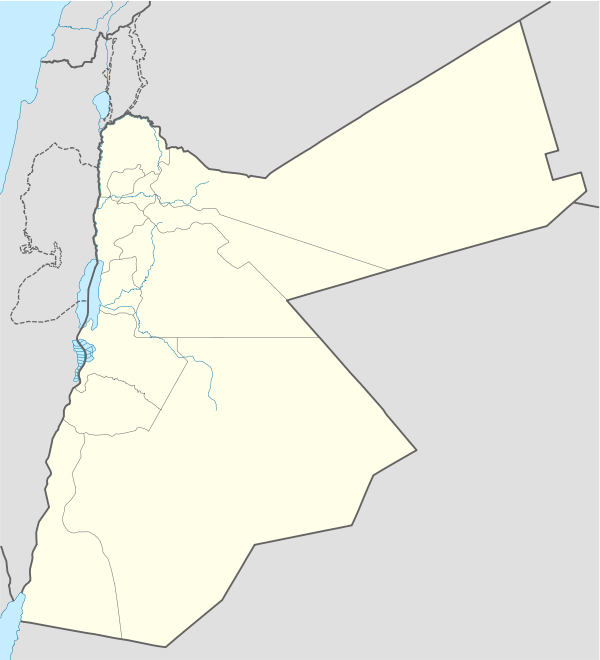Zahrat adh-Dhraʻ 2
Zahrat adh-Dhraʻ 2 or ZAD 2 is an early Neolithic archeological site 1 mile (1.6 km) north of the village of edh-Dhra on the Lisan Peninsula, in modern-day Jordan.
 Shown within Jordan | |
| Region | Jordan |
|---|---|
| Coordinates | 31.255°N 35.566111°E |
| Type | Tell |
| Area | 2,000 square metres (0.20 ha) |
| History | |
| Periods | PPNA / PPNB |
| Cultures | Neolithic |
| Site notes | |
| Excavation dates | 1999, 2001, 2002 |
| Archaeologists | Phillip C. Edwards |
| Condition | Ruins |
The site is a low, small tell mound, located in what is now an arid region that would have been far more hospitable during the settlement's occupation. It sits at an altitude of 650 feet (200 m) below sea level. Excavations were carried out to a depth of 1.5 metres (4.9 ft) in 1999 by Phillip C. Edwards of La Trobe University.[1] Several rounded stone buildings were found with plaster floors although lime-firing pyrotechnology was probably not used in their preparation. Archaeobotanical studies suggested that cultivation of wild crops was likely to have occurred on site. A large number of flint tools were found including sickles, picks, axes, drills, arrowheads and scrapers made from local flint sources. A few examples of stone tools made from other materials such as quartz, obsidian and quartzite were discovered. Other discoveries included a ceramic figure, greenstone, some copper ore and two incised fragments of burnt limestone showing geometric designs suggesting early Neolithic use of art and symbols.[2] Radiocarbon dates for the site range between 9140 and 8470 BC. This has suggested occupation during the Pre-Pottery Neolithic A and possibly during the transitional phase into the Pre-Pottery Neolithic B between 8800 and 8600 BC that was identified in 2002 by Danielle Stordeur and Frédéric Abbès.
Ghattas Jeries Sayej analyzed the lithic assemblage from the site providing comparison with other sites in the southern Levant. He found little discernible difference between the Khiamian and Sultanian assemblages and argued for an extension of the PPNA and later start of the PPNB in the southern Levant around 9200 BP.[3]
References
- Phillip C. Edwards and Emily House, The Third Season of Investigations at the Pre-Pottery Neolithic a Site of Zahrat adh-Dhraʿ 2 on the Dead Sea Plain, Jordan, Bulletin of the American Schools of Oriental Research, No. 347 (Aug., 2007), pp. 1-19, Published by: The American Schools of Oriental Research
- Avraham Negev; Shimon Gibson (July 2005). Archaeological encyclopedia of the Holy Land. Continuum International Publishing Group. p. 552. ISBN 978-0-8264-8571-7. Retrieved 10 July 2011.
- Ghattas Jeries Sayej (2004). The lithic industries of Zahrat adh-Dhraʻ 2 and the pre-pottery Neolithic period of the Southern Levant. Archaeopress. ISBN 978-1-84171-674-9.